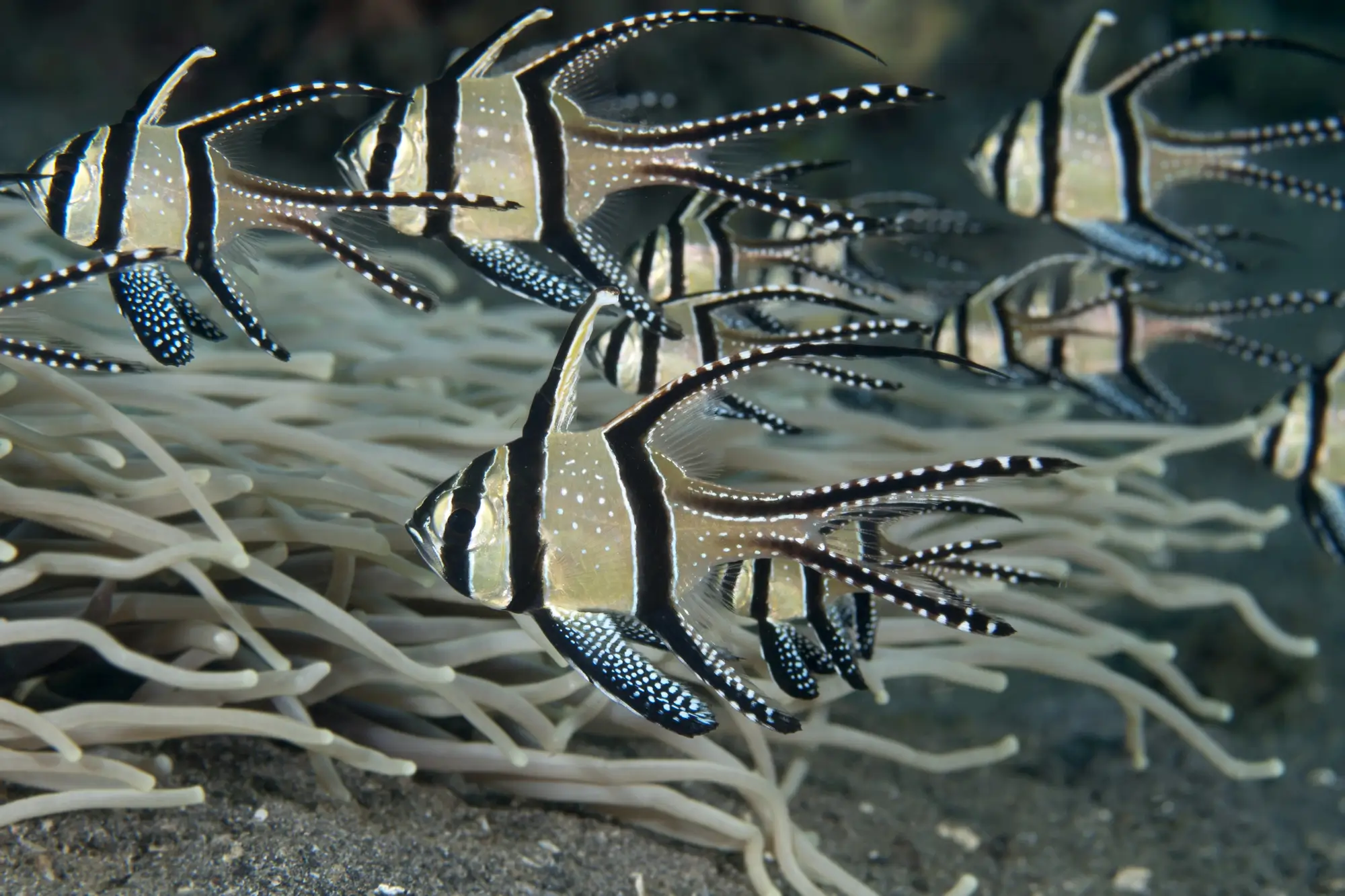Cardinalfish, also referred to as Cardinal fish, are a stunning species of reef fish popularly bought and sold worldwide for saltwater aquariums.
They are easy to care for and are generally peaceful and friendly fish that live harmoniously in aquariums with other similar-sized, non-aggressive species. Differing slightly in behavior depending on which species you choose to buy, Cardinal fish are always vibrant in coloration and character. As long as you purchase them from a sustainable captive breeder and care for them responsibly, you’re not contributing to their population decline in the wild, and are free to enjoy their life in your home aquarium!
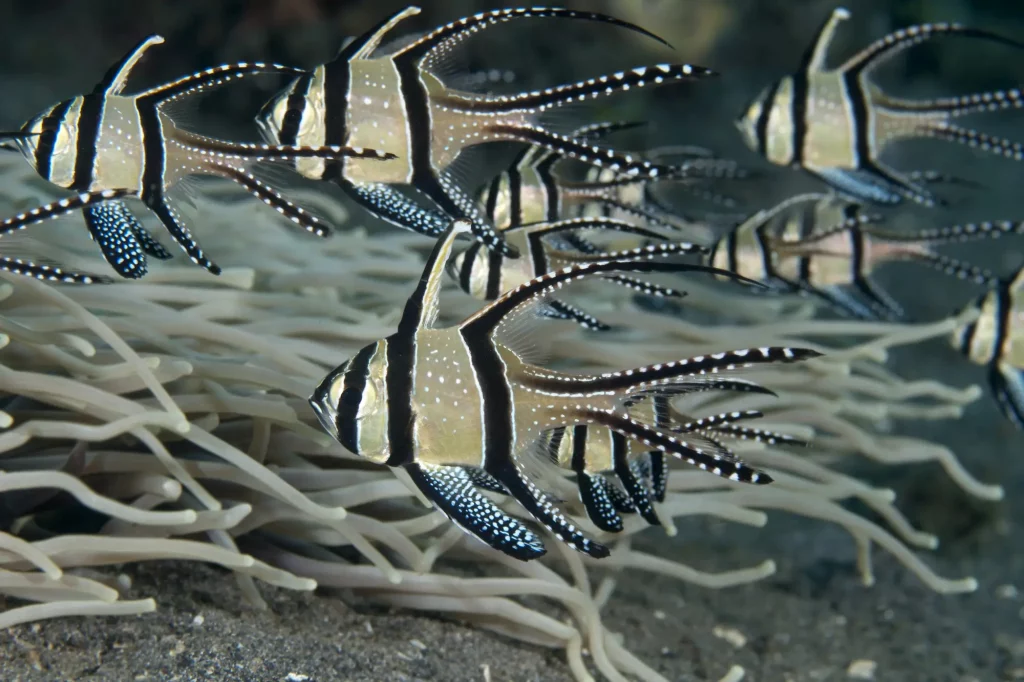
Understanding Cardinal Fish, Species Overview:
The most popular choice of Cardinalfish for home aquariums is the Banggai (sometimes also known as Kaudern’s) Cardinalfish. They co-exist easily with other fish species and other Cardinalfish, whilst also adapting well to life in captivity. They are generally curious and open swimmers, though they also enjoy small crevasses for occasional comfort.
Other sought-after kinds of Cardinalfish for saltwater aquariums include Pajama Cardinalfish, Seale’s Cardinalfish, and Yellow Cardinalfish, all of which are popular for the same reasons as the Banggai Cardinalfish.
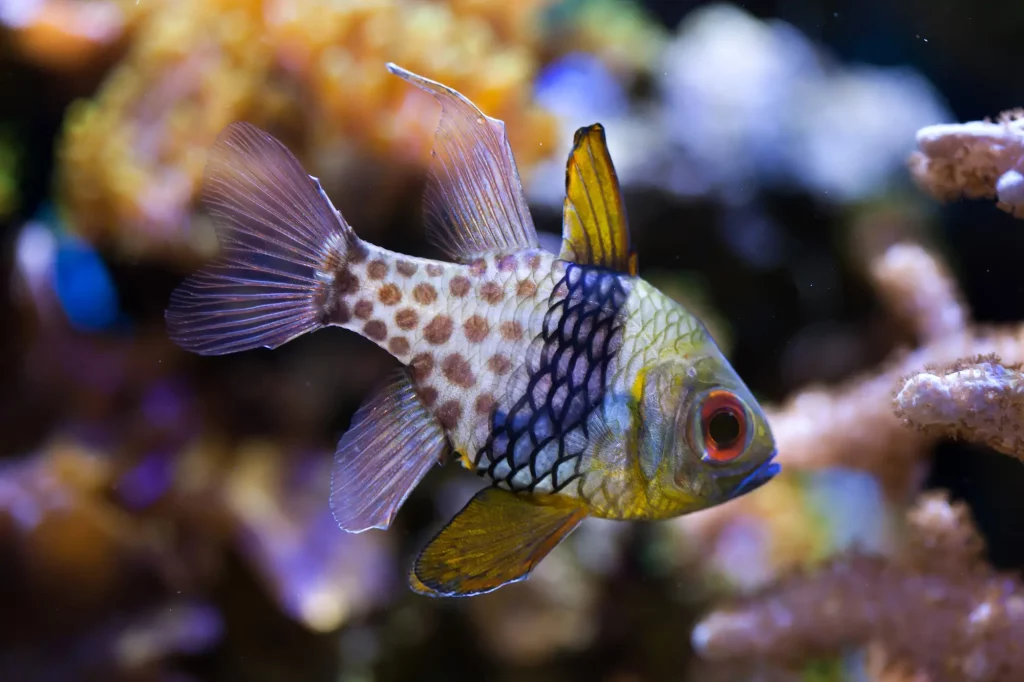
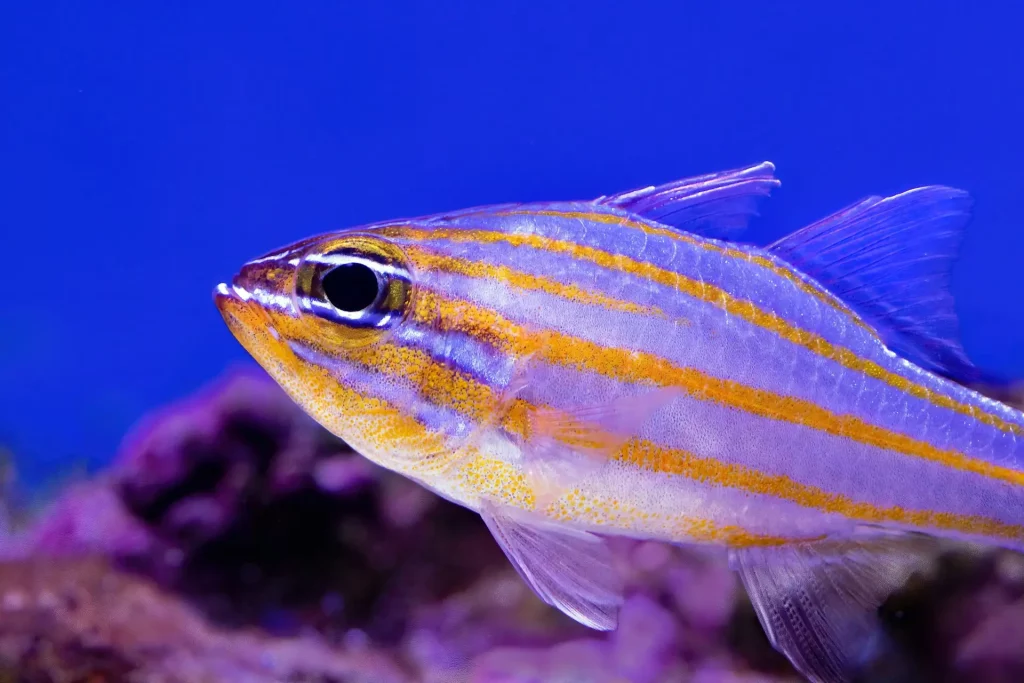
Sourcing Cardinalfish
Cardinalfish in the wild are generally found in tropical and subtropical reefs and lagoons, primarily in the Atlantic, Indian, and Pacific Oceans. Banggai Cardinalfish specifically, are native to the Banggai Islands of Sulawesi, Indonesia. This species of fish is classed as Endangered by the IUCN Red List of Threatened Species, and current populations are known to be decreasing. Thus, taking these fish from the wild is not a sustainable action, and therefore sourcing your Banggai Cardinalfish from ethical captive breeders is the suggested option for being a responsible aquarium owner.
Getting your Cardinalfish from sustainable captive breeders also increases the longevity of your Cardinalfish as those that are captive-bred are said to be better acclimated to living in captivity. Thus, they are less likely to die from the stress of extraction or introduction into a new habitat, which are common causes of death for aquarium fish from the wild. Captive-bred fish are also well-monitored for diseases and illnesses, which is a safer choice for the health of your aquarium and any other fish that you may already own.
Banggai Cardinalfish For Sale
There are various suppliers across the US that support and source their aquarium fish from sustainable aquaculture plants or captive breeders. Below is a comparison of just a few of these sustainable suppliers, specifically for Banggai Cardinalfish that grow to an adult size of about 3 inches long.
Prices range from $35 to $52, the lowest price being at the top.
| Supplier | Type, Size | |
|---|---|---|
| Live Aquaria | Banggai Cardinalfish, 3 inches. | Check Latest Price |
| Petco | Banggai Cardinalfish, 2 – 3 inches. | Check Latest Price |
| The Biota Group | Banggai Cardinalfish, 3 inches. | Check Latest Price |
| Seahorse Savvy | Banggai Cardinalfish, 3 – 3.5 inches. | Check Latest Price |
| Saltwaterfish | Banggai Cardinalfish, 2 – 3 inches. | Check Latest Price |
Introduction, Feeding and Health:
When introducing new Cardinalfish to your tank, it is important to do this with care. Fish are easily stressed creatures, and so to ease their transition into a new habitat and keep them calm, bringing them into a new tank in the darkness is best. Leaving them overnight before introducing light and food is also a safe option. Furthermore, be sure not to add the shipping water to the tank water, and also remember to give them time to acclimate and feel comfortable in your tank!
Ideal water conditions for Banggai Cardinalfish consist of at least 30 gallons of tank space, an average water temperature of 72 to 82 degrees Fahrenheit, and a pH level of 8 to 8.4.
Cardinalfish are small carnivores. In the case of Banggai Cardinalfish, they tend to feed on frozen or live prawns, rotifers, copepods, spirulina, krill, brine, and mysis shrimp, the last three of which are food items that contain nutrients that can naturally enhance the pigmentation of Cardinalfish.
With care and attention, Cardinalfish can live up to 5 years in captivity. With Banggai Cardinalfish, they are better kept as singles or in pairs (male and female), and introduced to a tank at the same time, as they can sometimes be known to pair up in bigger groups and bully the smaller fish of the school, sometimes to the point of death – this is not something you want! Furthermore, they are also sensitive to high levels of nitrates in the water, so it’s essential to monitor and maintain the water quality of the aquarium for the health of your Cardinalfish, and most likely your other aquarium fish too!
If you own frogfish, know that it won’t be a good tankmate for your prized Banggai cardinalfish, as seen in this video where a cardinal fish is gobbled by a frogfish in an aquarium.
Summary
Cardinalfish are an ideal choice for home aquariums due to their small size, vibrant colors, lively character, and their ability to adapt to new tank life with ease. However, in the wild, some species of Cardinalfish face the possibility of extinction, specifically the sought-after Banggai Cardinalfish. Thus, supplying your Cardinalfish from sustainable captive breeders is a more responsible choice than obtaining them from the wild, so as to protect natural populations and refrain from contributing to environmental damage. As aquarists, our love for fish and the ocean extends through tanks and into the sea, and thus we must safeguard our marine ecosystems for generations to come.
More information on Cardinalfishes
family Apogonidae
Common Name(s): Orangestriped cardinalfish (Apogon cyanosoma), Threadfin cardinalfish (Apogon leptacanthus), Flamefish (Apogon maculates), Ochre-striped cardinalfish (Apogon compressus), Hartzfeld’s cardinalfish (Apogon hartzfeldi), Ninebanded cardinalfish (Apogon novemfasciatus), Twospot cardinalfish (Apogon pseudomaculatus), Seale’s cardinalfish (Apogon sealei)
Reef Fish Guide designation and why
Although not all Cardinalfishes will be found at the local fish store, this family is known for its hardiness and brilliancy as adisplay fish. Because they are comfortable being kept in groups they are easy to breed and captive bred fish make the most sustainable choice for the home aquarium.
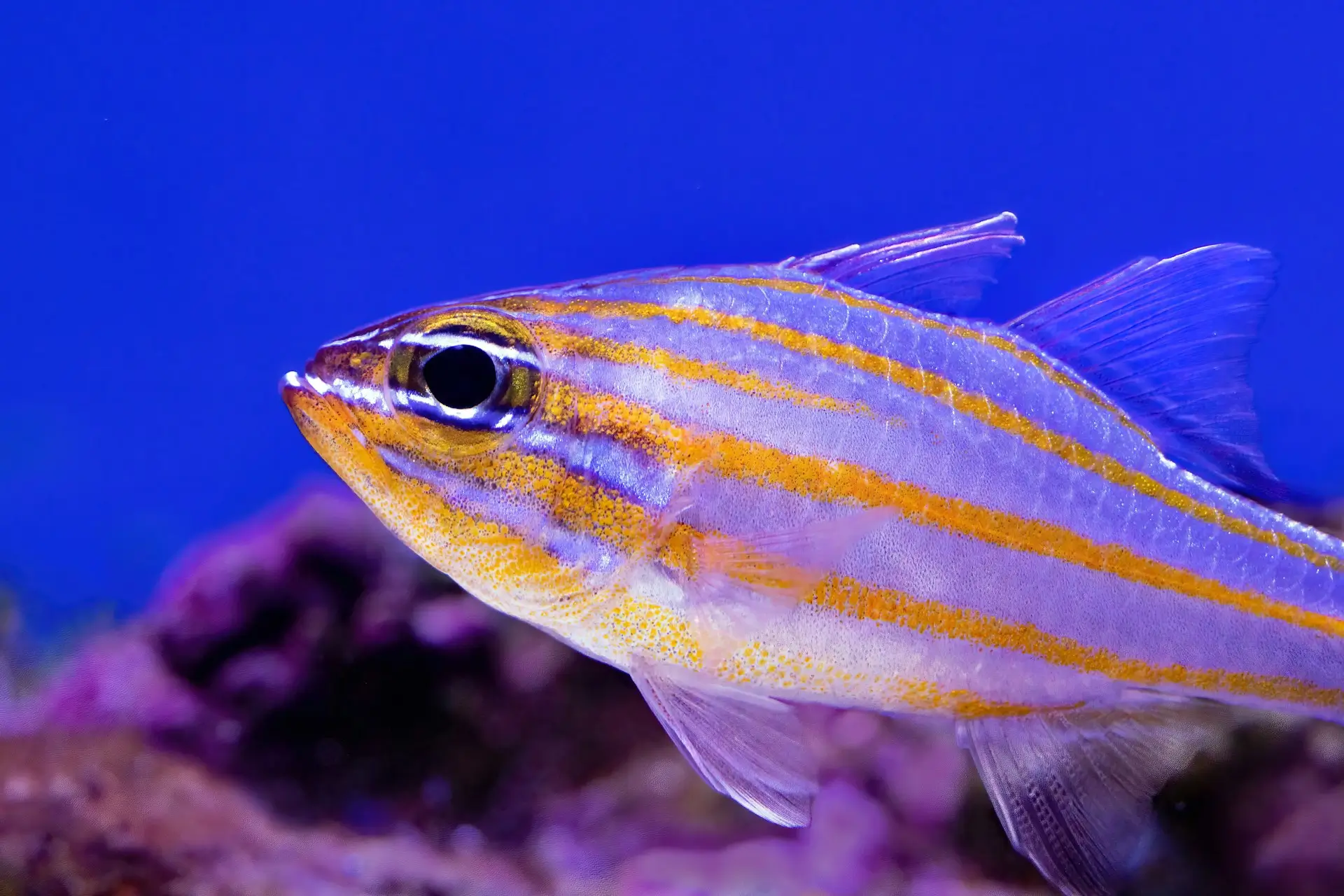
Distribution
Indo Pacific and Western Pacific, Red Sea south to Mozambique and east to Fiji, north to the Ryukyu and Bonin islands, south to New Caledonia; Tropical eastern Atlantic
Maximum Size
Ranges from 2.4 – 4.1 inches (6 – 10.5 cm)
Care Requirements
Cardinalfishes do best in large tanks but may be kept in a minimum tank size of 30 gallons. When looking to buy a Cardinalfish, make sure you carefully evaluate the particular species of interest because each breed displays differing personalities. Some are bold (like A. cyanosoma) and spend much of their time out in the open. They usually stay close to cover, unlike other Cardinalfish species that spend a lot of time hiding in holes and crevices. Cardinalfishes are an excellent fish to keep in reef tanks. It is important to provide many nooks and crannies for them to hide in. Some species will defend their home and in a well-lit tank they tend to take cover more often.
Food
Cardinalfishes from this family eat meaty foods including marine fish and crustacean flesh, mysid shrimp and frozen preparations. Feed them daily and watch their color because some species will fade if they are not fed a varied diet that includes vitamin-enriched and color-enhancing foods.
Compatibility
Most Cardinalfishes do best with docile tank mates. Being that they are so small, they may make a great snack for larger, more aggressive fish. They are non-predatory and typically non-aggressive, but some larger and feistier Cardinalfish species will pick on smaller ones. Besides A. maculates, these fish like being kept in aggregations of five or more individuals. If you keep many Cardinalfishes in your tank, add them at the same time. These fish are not a threat to other tank organisms but some have been known to eat delicate ornamental shrimp.
FAQ Corner
Are Banggai Cardinalfish reef-safe?
They are generally considered reef-safe and co-exist well with other non-aggressive fish of similar size.
Are Banggai Cardinalfish overfished?
Banggai Cardinalfish are overfished and heavily exploited for the aquarium trade. According to the IUCN Red List of Threatened Species they are listed as endangered.
How big do Banggai Cardinalfish get?
Adult Banggai Cardinalfish can grow up to a total of 3.5 inches in length, with 2 inches being the average standard length.
How big do Cardinalfish get?
Other types of Cardinalfish can range in size from 2 inches up to 8 inches.
Are Cardinalfish aggressive?
Cardinalfish are considered to be semi-aggressive. This means they can be aggressive, mostly to their species, especially when in a group setting. In these situations, they have been known to show territorial behavior, and also to pair up and bully the smaller fish of the school.
Are Cardinalfish endangered?
The population status of most species of Cardinalfish is either Data Deficient or classed as Least Concerned, meaning they do not face any known major threats and are abundant and widely distributed. The only Cardinalfish that is classed as Endangered is the Banggai Cardinalfish.
